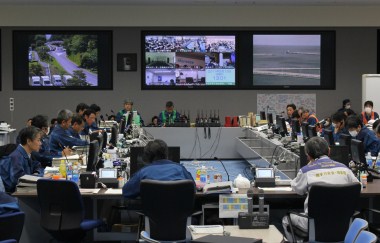Theory for Fukushima Daiichi 4 explosion
17 May 2011
A theory has emerged to explain the explosion at Fukushima Daiichi 4, despite no nuclear fuel being damaged there, based on an influx of hydrogen via pipework shared with unit 3.
Major damage was done to unit 4's reactor building some time on 15 March, but until now no technical explanation for this had been made known. Hydrogen explosions occurred at units 1 and 3, with the source of the gas being damage to fuel in the reactor vessels. However, unit 4 was undergoing maintenance with its core stored temporarily in the pond, leading observers to think unit 4's hydrogen explosion must have come as a result of damage to fuel in an overheating pond.
However, on 30 April a visual inspection of the pond revealed no serious disruption to the structures and fuel, apart from a scattering of debris. Tepco did not see the kinds of damage that would result from the pond boiling dry and the oxidation of the fuel.
 |
| Tepco's Emergency Response Room |
Now the company has put forward a theory based on a hydrogen explosion due to influx of gas via ventilation systems shared with unit 3. Warning its theory was 'presumptive', Tepco said hydrogen from venting unit 3 could have flowed into certain levels of unit 4 through its Standby Gas Treatment System (SGTS).
When called upon, the SGTS moves air from the reactor building to the environment through a series of filters and discharge via an exhaust stack. Its operation maintains low pressure within the reactor building and prevents any potentially contaminated air leaving through tiny holes. Fukushima Daiichi 3 and 4 share the same stack, used for this purpose as well as for venting from containment when a reactor is at high pressure.
Tepco said that hydrogen from unit 3 could have 'flown' into unit 4 during venting to emerge in five different locations on the 4th and 5th floor. The company has yet to ascertain whether the system valves were in a position to make this possible, but it considers damage to the building to be consistent with the theory.
It could also explain fires seen in unit 4 earlier on 15 March, which were reported at least twice but extinguished themselves without any intervention.
Researched and written
by World Nuclear News